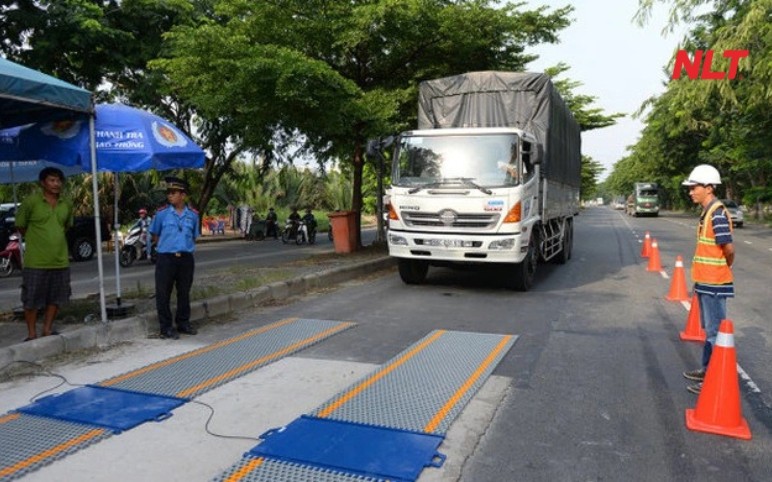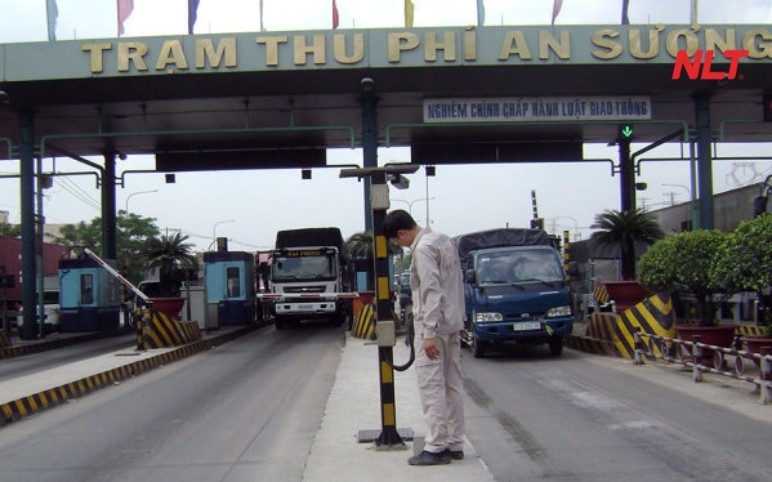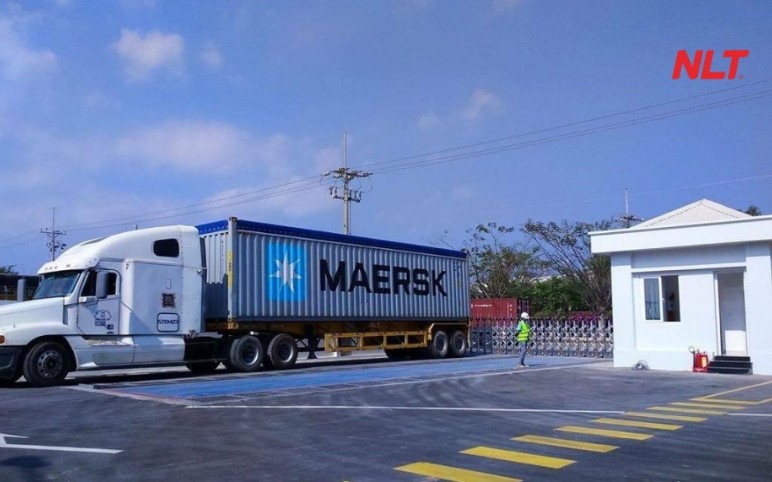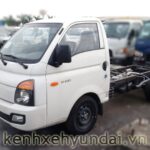In today’s increasingly complex traffic landscape with growing truck volumes, a weigh-in-motion (WIM) system plays a crucial role in ensuring traffic safety, protecting road infrastructure, and optimizing transport operations. Controlling vehicle weight not only helps minimize accidents but also extends the lifespan of roads and bridges while improving management efficiency and reducing infrastructure repair costs. This article delves into weigh-in-motion systems, from their concept, advantages, and operational structure to practical applications and the outstanding benefits this technology brings to businesses and society.
What is a Weigh-in-Motion System?
A weigh-in-motion (WIM) system, also known as a smart truck scale station, is an integrated technology solution that uses advanced equipment and software to automatically measure and control the weight of trucks and other transport vehicles. This system operates on the principle of using load sensors, smart cameras, and IoT data transmission technology, allowing continuous and accurate monitoring of vehicle weight while transmitting data to a management center for analysis and processing.
Unlike traditional weight control methods that are often time-consuming and labor-intensive, the weigh-in-motion system automates the process, minimizes human intervention, and ensures objectivity and transparency during inspections. This is especially important in managing large truck traffic volumes in key areas such as seaports, industrial zones, toll stations, and on highways.
Outstanding Advantages of Weigh-in-Motion Systems
The application of weigh-in-motion systems offers many practical benefits, surpassing traditional methods:
- Accurate and fast measurement: Using high-tech load sensors and advanced data processing algorithms, the system ensures high accuracy in weight measurement while minimizing waiting times for vehicles.
- Continuous and remote monitoring: IoT technology allows real-time data transmission to the operations center, enabling managers to monitor vehicle weight status anytime, anywhere, promptly detecting and handling violations.
- Process automation: The system operates automatically from weighing, license plate recognition, image recording to data analysis and violation alerts, minimizing manual intervention, saving manpower and operating costs.
- Effective violation detection: The weigh-in-motion system is equipped with AI cameras capable of recognizing license plates, detecting weight fraud, and recording images and videos as evidence for handling violations.
- Easy integration and expansion: The system can be integrated with other intelligent traffic management systems, such as automatic toll collection systems and vehicle access management systems, creating a comprehensive traffic management solution. At the same time, the system can be easily scaled up as needs increase.
- Detailed reporting and statistics: The system’s management software provides detailed reports and statistics on vehicle traffic, average weight, and the number of violating vehicles, helping managers gain an overview and make effective operational decisions.
 Automated weigh-in-motion system by NLT Group, an advanced solution for modern traffic management
Automated weigh-in-motion system by NLT Group, an advanced solution for modern traffic management
Structure and Operating Principle of a Weigh-in-Motion System
A complete weigh-in-motion system typically includes the following main components:
- Weighing platform: The part that directly contacts the vehicle, designed to be sturdy, withstand heavy loads, and have high durability. The weighing platform is installed on the road surface or sunken below the road surface, depending on requirements and installation location.
- Load sensors (Loadcells): Installed under the weighing platform, responsible for measuring the force exerted by the vehicle on the weighing platform and converting it into an electrical signal. Modern load sensors have high sensitivity and accuracy, ensuring reliable measurement results.
- Surveillance camera system: Includes a license plate recognition camera (ANPR – Automatic Number Plate Recognition) and a panoramic observation camera. The ANPR camera automatically recognizes and records the vehicle’s license plate, while the observation camera records images and videos of the vehicle during the weighing process.
- Controller and data processor: Receives signals from load sensors and cameras, performs processing algorithms to calculate vehicle weight, compares it with registered data, and determines whether the vehicle violates weight regulations.
- System management software: The control and management center for the entire system, allowing users to monitor real-time data, view statistical reports, configure the system, manage users, and export data.
- Communication system: Uses communication technologies such as 3G/4G/5G, Ethernet, or Wi-Fi to transmit data from the weighing station to the operations center, ensuring stable and continuous connection.
- Warning and display system: Includes signal lights, electronic boards displaying weight information, and traffic signs, providing visual information to drivers and authorities.
Operating principle:
When a vehicle moves across the weighing platform, the load sensors measure the force exerted and send a signal to the controller. At the same time, the license plate recognition camera automatically records the vehicle’s license plate. The controller processes the signals from the sensors and camera, calculates the vehicle’s weight, and compares it to the permissible weight according to regulations. If a weight violation is detected, the system automatically alerts, records images and videos of the violation, and sends the data to the management center for processing.
Applications of Weigh-in-Motion Systems in Practice
Weigh-in-motion systems are widely used in various fields, contributing to improved management efficiency and ensuring traffic safety:
- Road toll stations: Installing the system at toll stations helps control vehicle weight before entering highways or important roads, preventing overloaded vehicles from damaging the roads.
- Industrial zones and seaports: Controlling the weight of vehicles entering and exiting industrial zones and seaports helps manage cargo traffic, ensure internal traffic safety, and comply with weight regulations.
- Mineral and construction material mines: Monitoring the weight of vehicles transporting construction materials and minerals from mines and construction sites helps closely manage resources, prevent losses, and ensure traffic safety on transport routes.
- National and provincial highways: Installing the system on national and provincial highways helps control vehicle weight on a large scale, protect traffic infrastructure, and minimize accidents.
- Bridges and tunnels: Monitoring the weight of vehicles crossing bridges and tunnels helps ensure the structural safety of the works, especially weak and old bridges.
- Motor vehicle inspection centers: Using the system to check vehicle weight during the inspection process ensures that vehicles meet technical safety standards.
 Weigh-in-motion system installation at a toll station, contributing to the protection of traffic infrastructure
Weigh-in-motion system installation at a toll station, contributing to the protection of traffic infrastructure
Economic and Social Benefits of Weigh-in-Motion Systems
Investing in and deploying weigh-in-motion systems brings significant economic and social benefits:
Economic benefits:
- Reduced infrastructure maintenance and repair costs: Controlling vehicle weight helps reduce pressure on roads and bridges, extend the lifespan of the works, and reduce the costs of regular and unscheduled maintenance and repairs.
- Optimized operating costs: The system automates the weight control process, reduces manpower, and saves operating and management costs.
- Improved transport efficiency: Weight control helps transport businesses optimize cargo weight, improve transport efficiency, and reduce fuel costs and time.
- Increased budget revenue: Strict handling of weight violation cases helps increase budget revenue from administrative violation penalties, reinvesting in traffic infrastructure.
Social benefits:
- Ensured traffic safety: Controlling vehicle weight helps minimize the risk of traffic accidents caused by overloaded vehicles, protecting people’s lives and property.
- Environmental protection: Overloaded vehicles consume more fuel and emit more exhaust gases that pollute the environment. Weight control helps minimize environmental pollution from transport activities.
- Increased awareness of legal compliance: Automatic monitoring and strict handling of violations help raise awareness of legal compliance regarding weight among businesses and drivers.
- Building intelligent traffic systems: The weigh-in-motion system is an important part of an intelligent traffic system, contributing to building a modern, safe, efficient, and sustainable traffic system.
 Weigh-in-motion systems contribute to building intelligent and sustainable transportation systems.
Weigh-in-motion systems contribute to building intelligent and sustainable transportation systems.
NLT Group – A Pioneer in Providing Comprehensive Weigh-in-Motion Solutions
NLT Group is a leading company in Vietnam in the field of researching, developing, and providing intelligent weigh-in-motion system solutions. With a team of experienced, highly skilled engineers and cooperation with leading technology partners worldwide, NLT Group offers customers advanced, high-quality solutions that meet all the stringent needs and requirements of the market.
NLT Group’s weigh-in-motion system solutions stand out with:
- Modern technology: Applying advanced technologies such as IoT, AI, Cloud Computing, and Big Data to the system, ensuring high operating performance, absolute accuracy, and flexible scalability.
- Optimized design: The system is designed in a modular fashion, making it easy to install, operate, and maintain. The software interface is user-friendly and easy to use, suitable for many user groups.
- Diverse features: The system provides all the necessary features for monitoring vehicle weight, from weighing, license plate recognition, recording, data analysis, violation alerts to statistical reporting and remote management.
- Professional service: NLT Group provides professional consulting, design, installation, training, warranty, and maintenance services, ensuring that customers always receive the best support throughout the system usage process.
Conclusion
A weigh-in-motion system is an indispensable solution in modern traffic management. With outstanding advantages in accuracy, efficiency, automation, and integration capabilities, this system brings tremendous benefits to transport businesses, state management agencies, and society as a whole. Investing in a weigh-in-motion system is a wise decision, contributing to building a safe, efficient, sustainable, and intelligent traffic system. Contact Xe Tải Mỹ Đình for advice and to choose the weigh-in-motion system solution that best suits your needs.
Frequently Asked Questions
Can weigh-in-motion systems be integrated with other systems?
Yes, the weigh-in-motion system is designed to be easily integrated with other intelligent traffic management systems such as automatic toll collection systems, traffic light management systems, and vehicle access management systems, creating a comprehensive traffic management solution.
What is the accuracy of the weigh-in-motion system?
NLT Group’s weigh-in-motion system uses advanced load sensors and signal processing technology, ensuring high accuracy, typically achieving an error rate of less than ±1%, meeting international measurement standards and stringent monitoring requirements.
What is the investment cost for a weigh-in-motion system?
The investment cost for a weigh-in-motion system depends on many factors such as the size of the system, the technology used, the required features, and the accompanying services. For detailed information on costs and suitable solutions, please contact Xe Tải Mỹ Đình directly for specific advice and quotations.
Contact Information
For detailed advice on weigh-in-motion systems and other intelligent traffic solutions, please contact:
📠Address: 43R Ho Van Hue, Ward 9, Phu Nhuan District, Ho Chi Minh City 📞 Hotline: 0911 379 581 📧 Email: [email protected] 🌠Website: nlt-group.com
